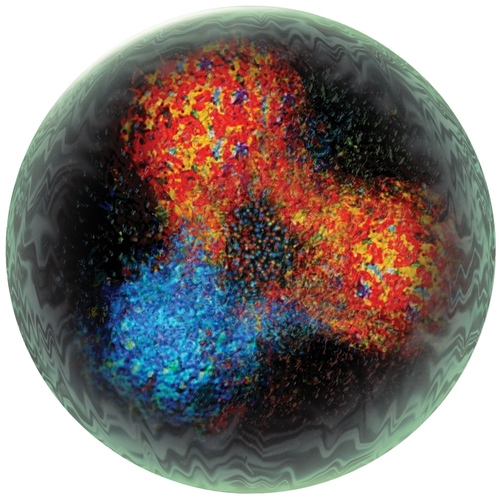Physicists at the Thomas Jefferson National Accelerator Facility, commonly called Jefferson Lab or JLab, recently determined the strength of the strong nuclear interaction at the largest distances recorded so far. Also called the strong force, the strong nuclear interaction is responsible for binding fundamental particles known as quarks into composite particles, including the protons and neutrons that comprise the nuclei of atoms. The scientists sought to answer the unresolved theoretical question of whether coupling—the strength of bodies interacting via the strong force—increases, decreases, or remains constant with distance. Results showed that at large enough distances, the distance dependency of the strong force coupling dropped out and coupling became constant. These findings provide experimental support for multiple theories including those accounting for the origins of the overwhelming majority of the mass of ordinary matter in the universe. See also: Atomic nucleus; Elementary particle; Fundamental interaction; Mass; Matter; Neutron; Proton; Quark; Strong nuclear interactions; Theoretical physics

For this study, the researchers used data from four separate experiments performed about a decade ago. All of the experiments involved shooting polarized electron beams at polarized proton or neutron targets. "Polarized" in this case means that the respective particles were mostly spinning in the same direction. Electromagnetic probing of protons and neutrons across the four experiments yielded enough data to make the new experimental determination. See also: Polarization of waves
Although the leveling off of coupling with distance has often been theoretically treated as validated due to mathematical requirements and previous determinations, the new study determined this coupling with a much higher degree of precision than had previously been achieved. Important predictions in theoretical physics rely on “freezing” the distance dependency. One such theory with this reliance explains the source of 99 percent of ordinary mass in the universe. Through prior experiments, scientists have determined that the mass of "up" and "down" quarks comprising protons and neutrons is very small—only a few megaelectronvolts (MeV). Yet overall, individual protons and neutrons each possess a mass of around 1,000 MeV. Only three quarks comprise protons and neutrons, though, thus leaving unexplained the origin of the majority of the particles' mass. See also: Electronvolt; Mathematical physics
Particles called gluons have been theorized to be the answer. Similar to the way in which photons are the force carrier particles of the electromagnetic force, gluons are the force carrier particles of the strong force. Each quark is surrounded by a cloud of such gluons. Interactions of the strong force between gluons and quarks increase the total potential energy of these particles. German-born U.S. theoretical physicist Albert Einstein’s famous mass-energy equivalence principle (represented by the equation E=mc2) allows this energy increase to function as a mass increase, which cumulatively accounts for the “missing” mass inherent in protons and neutrons. These interactions could not occur in a way that would agree with observations if the strong force did not level off with distance. See also: Electromagnetism; Energy; Gluons; Photon
The findings further bolster the application of new analytical techniques to quantum chromodynamics (QCD), the theory of the strong force and its interactions. At large enough distances, where coupling of the strong force is independent of scale, the force is described as "conformal." Being conformal allows for mathematical techniques such as Anti-de Sitter/Conformal Field Theory (AdS/CFT) to be applied to QCD. Many equations in QCD are not solved analytically, but instead through a mathematical technique known as perturbation analysis. As an example, consider a ball placed on a skateboard half-pipe, in which the goal is to find out where on this half-pipe the ball would come to equilibrium. Whereas solving several equations of motion could analytically find where the ball would come to rest, an alternative would be to place the ball at several different positions in the half pipe and then calculate from there which direction the ball would move. Iterating this process by gradually placing the ball closer to the anticipated point of equilibrium could provide a sufficient calculation for where the ball would come to rest. However, some equations in QCD cannot be solved by an iterative method such as this and must be solved analytically using different strategies. AdS/CFT is one such strategy. Researchers can now confidently use AdS/CFT not only to solve new equations, but also to re-solve QCD equations with a higher degree of accuracy than had been obtainable before. See also: Equilibrium of forces; Perturbation (mathematics); Quantum chromodynamics





